American Sabbatical 035: 10/18/96
Astoria
10/18.. Astoria
We didn’t go close enough to the water this morning to step in quicksand. The storm had lulled during
the night, but by the time we were done playing with puter in
the AM it was winding up for another pitch. Long Beach, Washington,
made from exhalations of the Columbia, boasts that it is “The
Longest Beach In The World.” And you can drive 50 miles on the
sands, if you so desire. We didn’t. It was surfing weather, and
the megarollers were cresting-up way offshore, booming onto the
beach, spume blowing off the tops. Dark squall-lines marched in
from outside, and we cut our stroll short when bolts of lightening
snapped in the darkness to the westward.
Peggy wanted to visit the World Kite Museum, just a block off
the beach, so I sat in the Red Owl and played with pen and ink.
KABOOM. Lightening and hail pounding on the Owl. Then SIZZLE-KABLAM.
A hard strike real close. Maybe a kite museum isn’t the place
to be when Old Ben starts playing upstairs. The fire sirens started
screaming. Turns out the local school was ground zero, about half
a block away. Small fire. Nobody hurt. But if He’s aiming for
teachers.. we slunk out of Long Beach with our tailfeathers tucked
low.
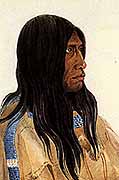
Sacajaweah?
(Bodmer painting of
Shoshone Woman)
|
From the electric sands we slid back into the historic record:
We last left Lewis and Clark clambering down the face of the Grand
Coulee Dam, didn’t we? Or was it eating apples in Wenatchee? Whatever.
Now we struck on the far end of the Lewis and Clark Trail, where
they finally saw the Pacific Ocean. Cape Disappointment. Maybe
it’s called that because of the weather. Which actually was appropriate
for historical reminiscence, since L&C spent a dismal four months
at the mouth of the Columbia subsisting on spoiled elk and sour
roots. We decided not to risk a boughten lunch there. |
| We did tour the interpretive center in an old WWII fortification
high above thrashing seas on the Columbia bar, one of the nastiest
bit of goods in the briny bag of tricks. Our friend Jimmy Chard
once was a Coast Guard crashboat skipper at the mouth of the Columbia,
and I thought of him with admiration looking out at the raging
turmoil between the great jetties extending seaward. Talk about
hotdog work. |
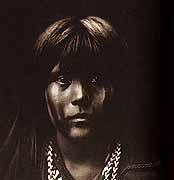
Sacajaweah?
(Curtis Photo of
Mojave girl)
|
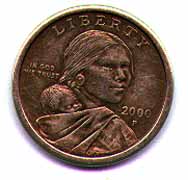
Sacajaweah?
|
Those other adventurers, Meriwether and William, cavorted on the
strand here. We ate garlic with cucumber sandwiches and bananas.
Sagajawea insisted on being allowed to see the great fish (whale)
rotting on the beach just south of the river mouth. All of us
have a special attraction we just have to see, and favorite food.
|
Before we left Washington State, I had one last quest to fulfill
here. I’d read a journal kept by a drunken deadbeat husband from
Boston who settled on this coast in the 1850’s, and I wanted to
remember his name, and figure out where he’d acted out his tales.
The director at the L&C center knew all. The ex-Bean Towner was
James Swan, and his homestead at Gray’s Harbor had been where
the road we took crossed over the Bone River (called Bone because
of the remains of a Chinook village decimated by imported disease).
I had a clear memory of the place, with a slow gig winding among
drenched marshes, from the day before. Swan’s journal, incidentally,
is a delight. All about a rowdy crew of outcasts, and the last
natives, living in a communal paradise of oysters and alcohol
until commercial zeal and government ambition spoiled the fun.
Our interpretive informant also told us that Swan was a proto-anthropologist
in his later years, who hung out with the Makah and sent materials
and info to Papa Franz (Boas), Margaret’s mentor.. a nice circle
of serendipity.
| Then we crossed the might Columbia into Astoria. I’d envisioned
a rough log village kind of place,with piles of pelts and blankets,
but I was only 180-odd years too late. It’s a big port of entry,
with all the cement amenities. Not the raw place Astor’s men and
the Hudson’s Bay Co. squabbled over in 1812. I think the tale
of that misadventure would make a great movie. The whole script
is ready to hand in Washington Irving’s ASTORIA. And those of
you who remember Irving as the intruding egoist of the Knickerbocker
tales will be surprised to find that he is a superb straight-ahead
historian in his book about Astoria. As pure reporter he ranks
with the best. |
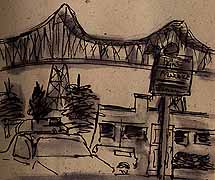
Astoria Bridge
|
Today’s Astoria ranks, well it just ranks. We decided to roll
on along the Columbia, so we put the Owl’s face back into the
downpour. The thought of communing with the dismals at Lewis and
C’s Fort Clatsop was too drear to contemplate. There were hills
and woods just beyond the curtains of rain, but all we caught
were dark impressions. We did see houses on barges (a local tax-dodge?)
lined up along the John Day River (town managers take note), and
got a marvelous view of the Trojan Nuclear Power Plant rearing
its one macho cooling tower beside a black ball of a containment
vessel. We thought that this was a perfect opportunity for Christo
to make a safesex statement. Otherwise the drive along the big
C to Portland was just a wet game of follow the semis. The tall
timber may be out there somewhere, but all we saw was secondgrowth
hardwoods, and “hybrid cottonwood” plantations (?). As you near
the Portland metro the Columbia Valley widens into the rich promised
bottomland of the 1840s, now thickly planted with suburban housing.
Where the storied river of paradise, the Willamette, joins the
flood, at the city limits, the industrial urb erupts and we were
jammed into 10-lane rush-hour bumpercars between tanktowns and
railyards with a view of the bulk loading docks. The muscles of
commerce flexing to a late Friday beat.
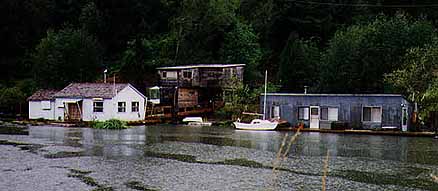
Floating Homesteads
The snowcapped Cascades were somewhere behind those towering black
clouds to the north, hidden by sheets of rain. Mt. St. Helens,
Mt. Adams, Mt. Hood. But like Rainier at Seattle, the sky gods
made it all obscure to us. Rain goddesses were out dancing.
We sashayed off the multi-lane into clogged sidestreets, moreorless
at random, and fetched up next to Powell’s City of Books, one
of Seth’s must-sees.. and you must. Powell’s has to be the best
bookstore in the world. Oops, there I go, Americanizing. It sure
is a dandy place to while away a Friday rush in the rain. Course
we were just windowshopping.. well, we did buy a couple.. anyhow.
A store that mixes new and used, that has as many titles about
American radical history as about U.S. military history, that
shelves its periodicals in the cafe.. we could hardly scratch
the surface in two hours.
| But we were bushed, and in urbashock, and slightly damp. So we
went out to get lost in traffic, succeeded beyond our dreams,
and found a pay-for-snooze where they hardwire the phones. Hello?
Hello? |
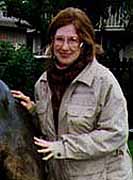
Memoist at work
|
(Memo #33)
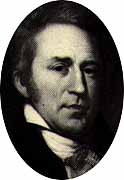
Clark
|
Oct. 18 - LEWIS &CLARK - Voyage’s End
WHO? Meriwether Lewis and William Clark
WHAT? two explorers hired by President Jefferson to explore the
Louisiana Purchase
WHERE ? museum at point where Columbia River joins the PACIFIC
WHEN? 1805 - 1806
HOW? Lewis and Clark wintered over in area on south shore of river
near Astoria, Ore.
Topics : Lewis & Clark expedition, preparation, relations with
first people
|
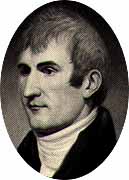
Lewis
|
|
Questions: What did Lewis & Clark take with them? How did they
prepare? How did they interact with Native Americans / First People?
What goods would you take for trade if you were exploring new
territory? What does the list of trade goods taken by Lewis and
Clark on their voyage show about First Nation needs and values?
To whom did these goods go? |
|
Lewis and Clark ended their transcontinental journey at the mouth
of the Columbia River (which divides the states of Oregon and
Washington). We had followed in their footsteps at many places
(especially through the Lochsa wilderness of Idaho) and we wanted
to see where their travels ended. There is an interpretive center
in a building on top of the cliff guarding the north side of the
river entrance, across from their winter camp at Astoria. A slide
show and exhibit gives many details about their journey. There
were many artifacts associated with the men and trip in the exhibit’s
display cases - trade goods, a commemorative medal given to First
People chiefs, a uniform coat.
Lewis and Clark did not blithely start off. The trip was well-planned
and well-provisioned. Their movements and actions were based on
information they collected, and logic. Before they left they both
studied useful skills - surveying, botany, geology, mapmaking,.
They took a 7 tons of supplies with them - gunpowder, lead, blankets,
axes etc., and the equipment to meet their needs - a forge, a
mill, medicines. They selected men with army and frontier experience
and took a black labrador pet named Seaman who was an excellent
watchdog during the trip. They were particularly lucky in their
choice of hired voyageurs, since one had a Shoshone wife (Sacajaweah)
whose brother helped them secure horses in the Rockies. They took
extraordinary notes accompanied with drawings and maps. They collected
over 200 plants which they pressed and transported to Washington.
Thomas Jefferson received and kept many artifacts from their trip.
| They knew they would meet many kinds of people on their travels
and they took a variety of goods for trade with Native Americans/First
People. The list is fascinating TRADE GOODS TAKEN include - tobacco
(130 rolls of pigtail tobacco), beads (73 multi-string bunches
and 8 & 1/2 lbs of red beads), bells, 22 yards of scarlet cloth,
72 pieces of ribbon, 4600 needles, 11 knives (dog), 14 lbs. knitting
pins (needles?), 2800 fish hooks , 8 brass kettles. |
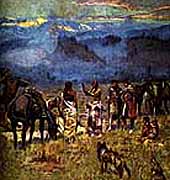
Meeting Shoshones
(Chas. Russell Painting)
|
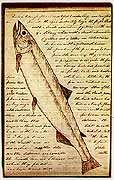
Salmon
(Lewis's Journal)
|
Thomas Jefferson’s instructions were very specific when it came
to interaction with First People: “ treat them in the most friendly
and conciliatory manner which their own conduct will admit”. Lewis
and Clark devised a ceremony for their first contact with each
First People tribe. They selected a site and spread an awning
overhead. They donned their formal and colorful uniforms and received
the chiefs standing under the awning. They would makes speeches,
listen to the First People’s chiefs, and distribute commemorative
medals. They repeated this ceremony dozens of times. |
Their success in dealing with First People is shown by the statistics
- only two men from the many tribes they contacted were killed.
They lost no men to hostiles.









